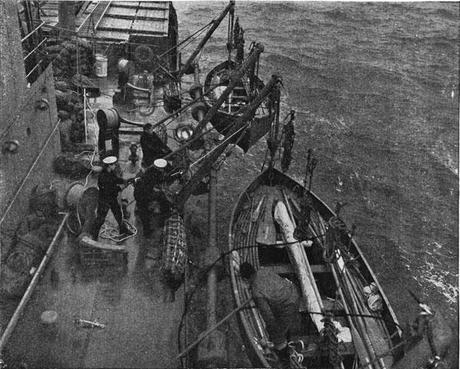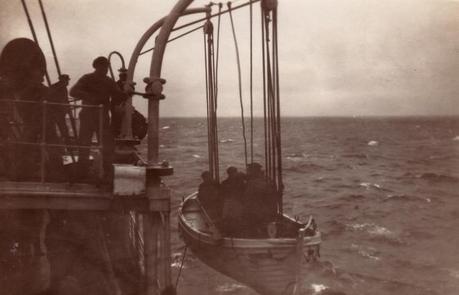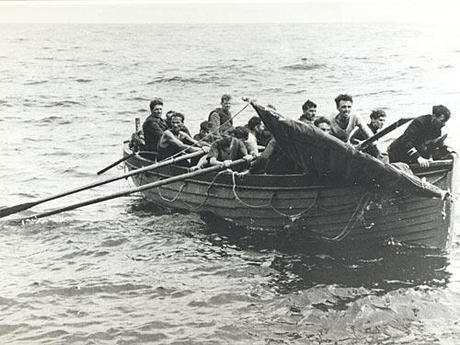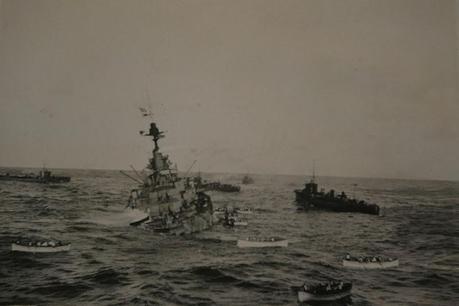[Crossposted from CharlesMcCain.com]
The most tragic moments in the lives of both merchant sailors and navy sailors in World War Two are the stories of the men who survived the sinking of their ships, then ended up in lifeboats or on rafts and drifted for weeks before being rescued or, in many cases, never rescued at all. Yet even before the men tried to survive in a lifeboat, crewmen first had to launch the lifeboat which was very difficult to do and if the ship went down fast, was never attempted.
In that time, launching a lifeboat from a ship wasn’t easy even if the ship wasn’t sinking. First, the lifeboat was held in davits and was normally kept inboard, that is inboard of the ship’s rail, secured by ropes tied to ring bolts on the deck. And they had it well secured so they wouldn’t come adrift in a storm. To lower the boat, sailors had to first find, then cut, the inboard mooring ropes. Night, rain, snow, fire, panic and such, all added to the difficulty.

Once free, the boat had to be hauled out of its chocks using main force by ropes attached to davits until the boat was higher than the deck rails. Sailors then pushed the boat outboard as the davits holding the boat were winched outboard until the boat was over the water. This required sailors who were both well trained and had immense physical strength. Sailors then held the boat steady so it wouldn’t bash against the ship while passengers and crew climbed into it. After the boat was filled with people, a sailor had to stand at each davit, then lower the boat by the ropes, or falls, which attached the boat to the davits. And the two sailors had to do this in perfect synchronization or one end of the lifeboat would tip downwards and people would fall out. This happened all the time.
These falls were a set of ropes and winches arranged in such a way that the full weight of the lifeboat wasn’t on the men because two sailors could hardly take the strain of holding a lifeboat filled with people. In bad weather, the falls often froze and the rope would not run through them. In that event, the lifeboat could not be lowered. If the ship was listing to port or starboard by more than five degrees or so, the boats on the higher side could not be launched.

Because it was so difficult to launch lifeboats, they often went down with the ship. Since the lifeboats had sealed buoyancy chambers designed to keep them afloat even if they filled with water, the pressure of their buoyancy tugged against the ropes holding them fast to the ship. Often a lifeboat would come loose and literally rocket to the surface, occasionally injuring or killing sailors in the water.
Lifeboats were pre-stocked with food and water along with sets of navigating instruments. Almost all lifeboats had a mast with a sail and proper ropes attached. Men had to step the mast, that is raise the mast, then the boat was ready to sail. This required calm weather and men who had their wits about them and weren’t terrified along with an officer or petty officer who could actually sail as well as navigate. British merchant marine lifeboats had red sails so they could easily be spotted. Before any thought could be given to sailing, the lifeboat had to be rowed away from the ship. This wasn’t so easy because most crewmen didn’t know how to row.

Imagine the scenario: you are in a mild state of shock, at best, because your ship has been torpedoed and you have been forced to abandon her. You get aboard a lifeboat and launch into a rough sea. In a few minutes you are usually soaking wet because moisture from the waves is blowing on you. Now you must manhandle the oars – which are a minimum of twenty feet long – from the bottom of the lifeboat and fix them in the thwarts. Then, trying to maintain an even stroke with the others, you heave on your oar. It is brutally exhausting.
From How To Abandon Ship:
It is difficult to row in a heavy sea. The men can last at it about fifteen minutes, and, by making every stroke count, can perhaps get a half mile from the ship.
Getting away from the sinking ship was critical so as not to be sucked down when she sank. A lot of men were drowned this way.

